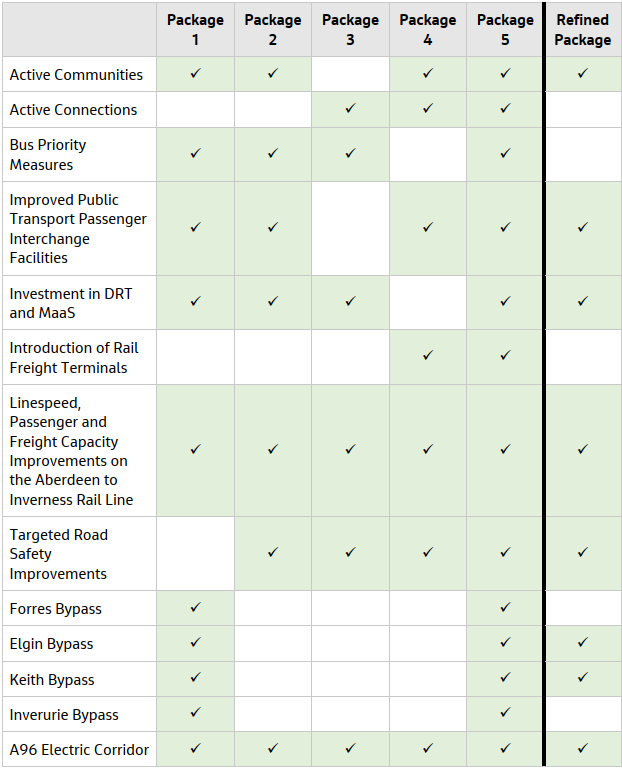A96 Corridor Review Summary
Corridor Overview
The Inverness to Aberdeen transport corridor passes through the council areas of Highland, Moray, Aberdeenshire and Aberdeen City. The corridor includes a number of settlements, including Inverness, Nairn, Forres, Elgin, Fochabers, Keith, Huntly, Inverurie, Kintore, and Aberdeen. These settlements are linked by the A96 Trunk Road, which provides strategic road connectivity between urban and rural areas. The surrounding environment is predominantly rural, with extensive areas of agricultural land, sensitive designated natural heritage areas and a significant number of cultural heritage features, including battlefields, scheduled monuments and listed buildings. The corridor is subject to flood risk from surface water and coastal flooding.
Appraisal
The appraisal process for the A96 Corridor Review is being carried out in three phases and has considered all relevant transport modes within the A96 corridor, including active travel, public transport, rail and roads-based transport. The Scottish Transport Appraisal Guidance (STAG) stages to be completed for the review are:
- Preliminary Options Appraisal
- Detailed Options Appraisal
- Monitoring and Evaluation Plan.
More detail on each of these stages is provided in the main Environmental Report.
Preliminary and Detailed Appraisal Process
Sixteen transport intervention options were assessed at the Preliminary Appraisal stage. As the current plan is to fully dual the A96 route between Inverness and Aberdeen, it was considered appropriate that the A96 Full Dualling option should be progressed to the Detailed Appraisal stage as it has already been the subject of a Preliminary Appraisal undertaken in 2014 that established the Inverness to Aberdeen Corridor Study A96 Dualling Inverness to Aberdeen Strategic Business Case. Early in the Preliminary Appraisal process, it was also identified that the Active Hubs option would clearly align with and sit within Transport Scotland’s Strategic Transport Projects Review (STPR2) recommendation 22 (Framework for Delivery of Mobility Hubs), and therefore this was determined to be the most appropriate mechanism by which to progress this option at a national level.
At the Preliminary Appraisal stage, there was an ‘option cleaning’ process, which removed a significant number of duplicate options. Following on from this cleaning process, a total of 227 options were retained as part of the ‘cleaned’ long list of options that was used as an input into the option sifting process. The option sifting also removed many more options, for a variety of reasons, including options that were out of scope, did not address regional problems or opportunities or deliverability concerns.
Following the Preliminary Appraisal, options that remained in consideration progressed to Detailed Appraisal. At this stage, multimodal ‘packages’ were developed in line with STAG, with an ‘area-based’ approach to group options together in order to enhance characteristics in locations with a similar nature throughout the A96 corridor. Options were therefore assessed in the Detailed Appraisal as packages of interventions, and from hereon will be referred to simply as packages.
Although each package was appraised individually, where appropriate and relevant, a number of individual options are included in more than one package.
An assessment of the benefits and contribution of the individual options to the performance of the overall packages was undertaken as part of the STAG appraisal. This has included additional detailed assessment using the available transport models to examine the impact of those options that could be represented in the models on an individual basis and determine what proportion of the total benefits they would provide.
The additional assessments allowed the better performing options to be identified and these were combined to form an additional package, referred to as the Refined Package. This package was developed to maximise the level of potential benefits provided by combining the best performing options, whilst optimising investment within the corridor and delivering value for money.
A full description of the A96 Corridor Review appraisal process is provided in the A96 Corridor Review Strategic Business Case Transport Appraisal Report .
The transport interventions included in each package are listed in Table 2.1. In addition to the packages listed in Table 2.1, full dualling was also assessed in the SEA. The results of the assessment are summarised in Section 7 of this Non-Technical Summary.
Table notes:
* Active Communities are only considered within the bypassed communities of Forres, Elgin, Keith and Inverurie, as well as Nairn, as this would be bypassed through the A96 Dualling Inverness to Nairn (including Nairn Bypass).
** Active Communities are only considered within the settlements and along the A96 Trunk Road sections related to Package 2, specifically Lhanbryde, Mosstodloch, Fochabers, Huntly, Kintore and Blackburn.
*** Active Communities are considered in the settlements of Nairn, Forres, Elgin, Lhanbryde, Mosstodloch, Fochabers, Keith, Huntly, Inverurie, Kintore and Blackburn.
Table 2.1: A96 Corridor Review Transport Packages and Interventions
